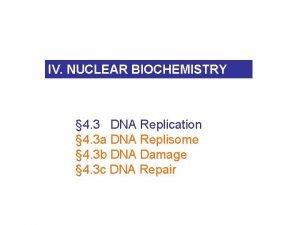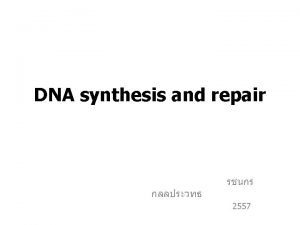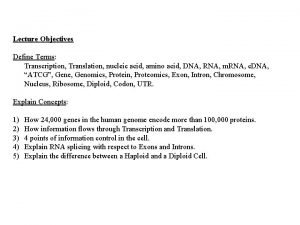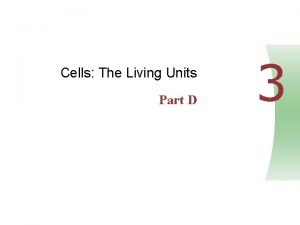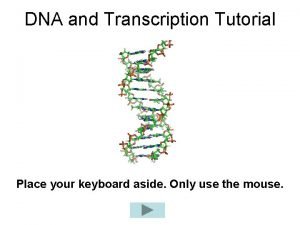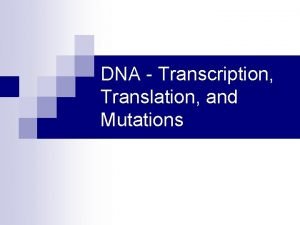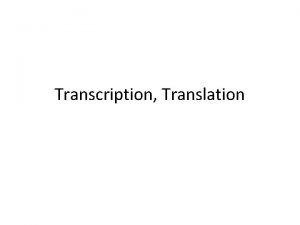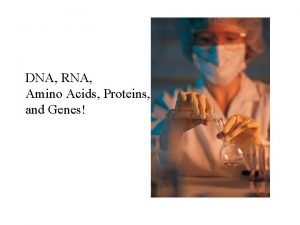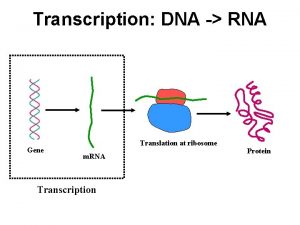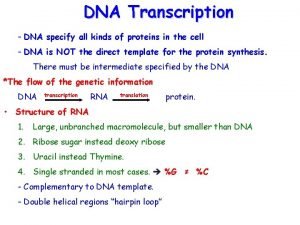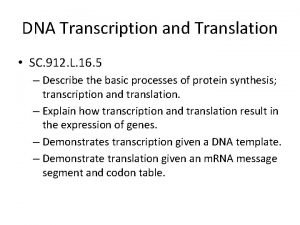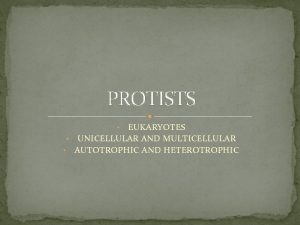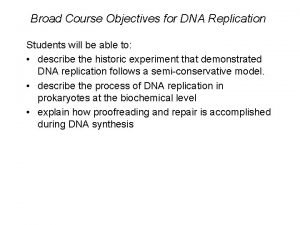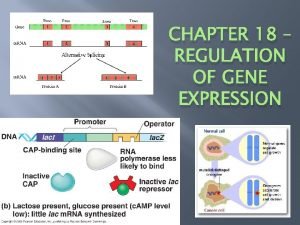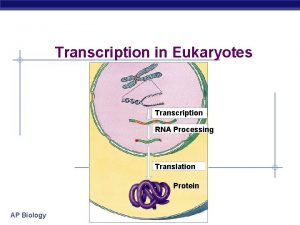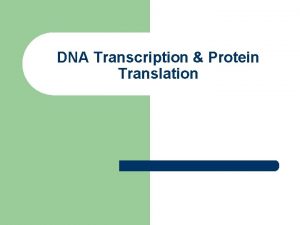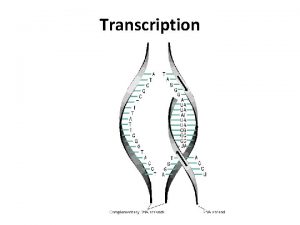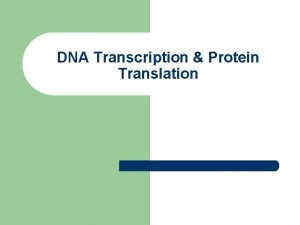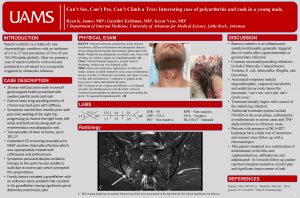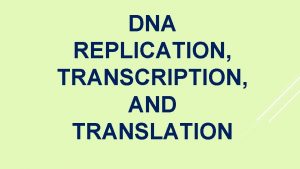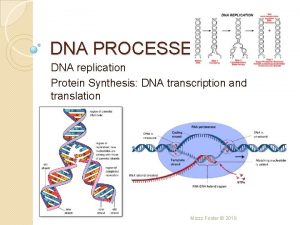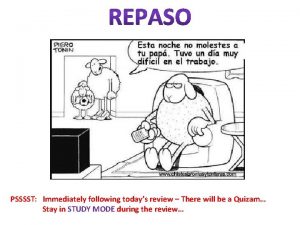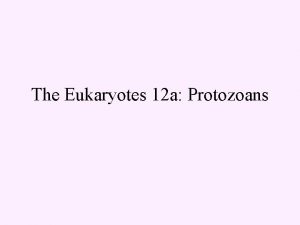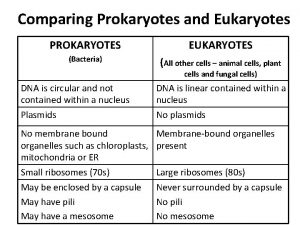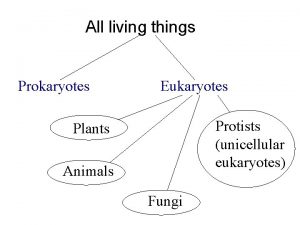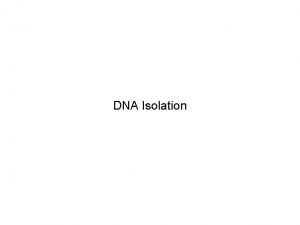Transcription in Eukaryotes Transcription Psssst DNA cant leave





























- Slides: 29

Transcription in Eukaryotes Transcription Psssst… DNA can’t leave nucleus! RNA Processing Translation Protein AP Biology 2007 -2008

Transcription in Eukaryotes 3 RNA polymerase enzymes u RNA polymerase 1 only transcribes r. RNA genes makes ribosomes u RNA polymerase 2 u RNA polymerase 3 u AP Biology transcribes genes into m. RNA only transcribes t. RNA genes each has a specific promoter sequence it recognizes

Transcription in Eukaryotes Initiation complex u transcription factors bind to promoter region upstream of gene suite of proteins which bind to DNA w turn on or off transcription TATA box binding site w recognition site for transcription factors u transcription factors trigger the binding of RNA polymerase to DNA AP Biology

Post-transcriptional processing Primary transcript (pre-m. RNA) u eukaryotic m. RNA needs work after transcription m. RNA processing (making mature m. RNA) u u m. RNA splicing = edit out introns il a t protect m. RNA from enzymes in cytoplasm oly-A 3' 3' p AA A A add 5 cap A ’s m. RNA p 50 A a 2 c 0 5 5' PPP add poly. A tail 5' G intron = noncoding (inbetween) sequence ~10, 000 bases eukaryotic DNA exon = coding (expressed) sequence primary m. RNA transcript AP Biology mature m. RNA transcript pre-m. RNA ~1, 000 bases spliced m. RNA

Whoa! I think we just broke a biological “rule”! Splicing enzymes sn. RNPs u u small nuclear RNA exon proteins Spliceosome u u exon 3' spliceosome 5' 3' cut & paste No, not smurfs! “snurps” AP Biology intron 5' several sn. RNPs recognize splice site sequence sn. RNPs sn. RNA mature m. RNA lariat 5' exon 5' 3' exon 3' excised intron

Ribozyme 1982 | 1989 RNA as ribozyme some m. RNA can even splice itself u RNA as enzyme u Sidney Altman AP Biology Yale Thomas Cech U of Colorado

Translation from nucleic acid language to amino acid language AP Biology 2007 -2008

Bacterial chromosome Translation in Prokaryotes Transcription m. RNA Translation Psssst… no nucleus! protein Cell membrane Cell wall AP Biology 2007 -2008

Translation in Prokaryotes Transcription & translation are simultaneous in bacteria DNA is in cytoplasm u no m. RNA editing u ribosomes read m. RNA as it is being transcribed u AP Biology

Translation: prokaryotes vs. eukaryotes Differences between prokaryotes & eukaryotes u time & physical separation between processes u AP Biology takes eukaryote ~1 hour from DNA to protein RNA processing

Translation in Eukaryotes AP Biology 2007 -2008

From gene to protein DNA transcription m. RNA leaves nucleus through nuclear pores AP Biology nucleus translation a a protein a ribosomea cytoplasm a a a proteins synthesized by ribosomes using instructions on m. RNA

How does m. RNA code for proteins? DNA 4 ATCG TACGCACATTTACGCGG m. RNA AUGCGUGUAAAUGCGCC 4 AUCG protein ? Met Arg Val Asn Ala Cys Ala 20 AP Biology How can you code for 20 amino acids with only 4 nucleotide bases (A, U, G, C)?

m. RNA codes for proteins in triplets DNA TACGCACATTTACGCGG codon m. RNA AUGCGUGUAAAUGCGCC ? protein AP Biology Met Arg Val Asn Ala Cys Ala

The code Code for ALL life! strongest support for a common origin for all life u Code is redundant several codons for each amino acid 3 rd base “wobble” u u Why is the wobble good? Start codon u u AP Biology AUG methionine Stop codons u UGA, UAG

How are the codons matched to amino acids? DNA 3 5 5 3 TACGCACATTTACGCGG m. RNA AUGCGUGUAAAUGCGCC codon t. RNA amino acid AP Biology 3 5 UAC Met GCA Arg CAU anti-codon Val

From gene to protein DNA transcription m. RNA translation a ribosomea AP Biology a a a a protein a a a nucleus cytoplasm

Transfer RNA structure “Clover leaf” structure anticodon on “clover leaf” end u amino acid attached on 3 end u AP Biology

Ribosomes Facilitate coupling of t. RNA anticodon to m. RNA codon u organelle or enzyme? Structure ribosomal RNA (r. RNA) & proteins u 2 subunits u large small AP Biology E P A

Ribosomes A site (aminoacyl-t. RNA site) u P site (peptidyl-t. RNA site) u holds t. RNA carrying next amino acid to be added to chain holds t. RNA carrying growing polypeptide chain Met E site (exit site) u AP Biology empty t. RNA leaves ribosome from exit site U A C A U G 5' E P A 3'

Building a polypeptide Initiation brings together m. RNA, ribosome subunits, initiator t. RNA u Elongation adding amino acids based on codon sequence u Termination 3 2 1 end codon u Val Leu Met Met Leu Ala Leu release factor Ser Trp A C t. RNA G U AC 5' CUGAA U m. RNA A U G 3' E P A AP Biology 5' U A C G A C AA U G CU G 5' 3' U A C GA C A U G C UG AAU 3' 5' U A C G A C AA U AU G C U G 3' A CC U GG U A A 3'

Protein targeting Signal peptide u address label Destinations: start of a secretory pathway AP Biology secretion nucleus mitochondria chloroplasts cell membrane cytoplasm etc…

RNA polymerase DNA Can you tell the story? amino acids exon intron t. RNA pre-m. RNA 5' cap mature m. RNA aminoacyl t. RNA synthetase poly. A tail large ribosomal subunit polypeptide 5' small ribosomal subunit AP Biology t. RNA E P A ribosome 3'

Can you tell the story? AP Biology

Translation Codons u AP Biology blocks of 3 nucleotides decoded into the sequence of amino acids

Wrap up The flow of genetic information from DNA to protein in eukaryotic cells is called the central dogma of biology. (a) Explain the role of each of the following in protein synthesis in eukaryotic cells. The central dogma does not apply to some viruses. Select a specific virus or type and explain how it deviates from the central dogma. Cells regulate both protein synthesis and protein activity. Discuss TWO specific mechanisms of protein regulation in eukaryotic cells AP Biology

Anwers AP Biology

AP Biology

AP Biology
 If you cant measure it you cant improve it
If you cant measure it you cant improve it You can t manage what you don t measure
You can t manage what you don t measure Prokaryotic vs eukaryotic transcription
Prokaryotic vs eukaryotic transcription Rna polymerase
Rna polymerase Intercalating agents
Intercalating agents How many dna polymerase in eukaryotes
How many dna polymerase in eukaryotes Types of dna polymerase in eukaryotes
Types of dna polymerase in eukaryotes Helicaee
Helicaee Dna transcription and translation
Dna transcription and translation Dna to rna transcription
Dna to rna transcription Dna and transcription tutorial
Dna and transcription tutorial Transcription and translation venn diagram
Transcription and translation venn diagram Dna code
Dna code Dna coloring transcription and translation
Dna coloring transcription and translation Dna replication transcription and translation
Dna replication transcription and translation Dna transcription
Dna transcription Rna
Rna Dna transcription
Dna transcription Dna transcription
Dna transcription Replication process
Replication process Function of dna polymerase 3
Function of dna polymerase 3 Dna rna protein synthesis homework #2 dna replication
Dna rna protein synthesis homework #2 dna replication Bioflix activity dna replication dna replication diagram
Bioflix activity dna replication dna replication diagram Coding dna and non coding dna
Coding dna and non coding dna Multiple choice questions on prokaryotes and eukaryotes
Multiple choice questions on prokaryotes and eukaryotes Unicellular and heterotrophic
Unicellular and heterotrophic Linear chromosomes in eukaryotes
Linear chromosomes in eukaryotes Prokaryotes vs eukaryotes gene regulation
Prokaryotes vs eukaryotes gene regulation Prokaryotic and eukaryotic venn diagram
Prokaryotic and eukaryotic venn diagram Are cell walls prokaryotic or eukaryotic
Are cell walls prokaryotic or eukaryotic




